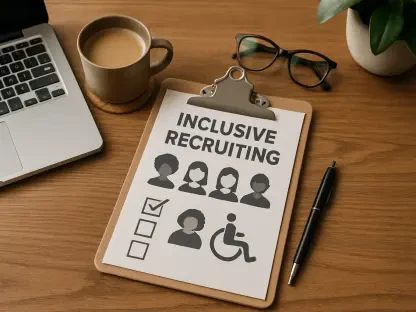The landscape of UK workplaces reveals a troubling statistic: one in four workers report experiencing discrimination or microaggressions tied to their diversity, background, or identity, raising urgent questions about the effectiveness of Diversity, Equity, and Inclusion (DEI) initiatives. Despite their prominence, these initiatives often fail to translate into meaningful change, highlighting a critical gap between rhetoric and reality as societal expectations evolve and legal scrutiny intensifies.
This summary delves into the persistent challenges surrounding DEI implementation in UK workplaces, drawing on comprehensive survey data and expert insights. It explores why these efforts frequently fall short, the implications for employees and organizations, and the steps needed to bridge this divide. The significance of this issue extends beyond compliance, touching on innovation, employee well-being, and the broader cultural maturity of workplaces in a rapidly changing world.
Unveiling the DEI Gap in UK Workplaces
A noticeable disparity exists between the visibility of DEI initiatives and their practical application across UK organizations. While many companies publicly champion diversity and inclusion, the lived experiences of employees often tell a different story, marked by ongoing discrimination and subtle biases that undermine trust. This gap not only affects individual workers but also shapes the overall health of organizational culture, raising concerns about authenticity in these efforts.
Survey data from a leading staffing firm highlights key challenges, including persistent microaggressions and inadequate cultural adaptation to diverse needs. Employees frequently encounter barriers that reflect a lack of genuine commitment, such as dismissive attitudes toward reasonable accommodations or entrenched biases in decision-making processes. These issues point to systemic shortcomings that cannot be addressed through surface-level policies alone.
Critical questions emerge from this disconnect: Why do DEI initiatives often fail to deliver tangible results? How do these failures impact employee morale and retention? Addressing these concerns requires a deeper examination of workplace practices and a shift toward strategies that prioritize real inclusion over mere visibility, ensuring that every individual feels valued and supported.
Context and Importance of DEI in the UK
The emphasis on DEI in UK workplaces has grown significantly in recent years, fueled by societal shifts toward greater equality and heightened employee expectations for fair treatment. Organizations are increasingly recognizing that diversity is not just a moral imperative but a competitive advantage, essential for attracting talent in a diverse labor market. This cultural evolution reflects a broader demand for workplaces to mirror the values of an inclusive society.
Beyond compliance with legal standards, DEI plays a pivotal role in driving innovation and enhancing employee well-being, which in turn contribute to business success. Companies that foster inclusive environments often see improved collaboration and creativity, as diverse perspectives lead to more robust problem-solving. Moreover, genuine inclusion strengthens employee loyalty, reducing turnover and building a more resilient workforce.
The broader implications of DEI extend to legal and societal spheres, with a notable rise in employment tribunal cases signaling dissatisfaction with current practices. This trend underscores the urgency for authentic inclusion that aligns with modern standards, rather than token gestures that fail to address deep-rooted issues. As expectations continue to rise, workplaces must adapt to meet these demands or risk reputational and financial consequences.
Research Methodology, Findings, and Implications
Methodology
To assess the state of DEI in UK workplaces, a comprehensive candidate survey was conducted by a prominent staffing firm, capturing the experiences of a wide range of employees across industries. The methodology focused on gathering quantitative data on discrimination and bias, while also incorporating qualitative feedback to provide context to the numbers. This dual approach ensured a holistic view of the challenges faced by workers.
In addition to survey data, the analysis included expert opinions from industry leaders such as Cindy Gunn and Emma-Louise Taylor, whose insights added depth to the findings. Their perspectives on HR strategies and cultural transformation helped frame the data within the broader context of organizational behavior. This combination of empirical evidence and professional commentary offered a robust foundation for understanding DEI shortcomings.
Findings
The survey results paint a concerning picture, revealing that one in four workers have encountered discrimination or microaggressions related to their identity or background. Furthermore, a significant portion—15.63%—reported that bias impacts hiring and career advancement opportunities, while 11.65% highlighted disability-related discrimination as a barrier. These figures indicate a pervasive issue that undermines workplace equity.
Legal trends further underscore the severity of these challenges, with employment tribunals recording 42,000 single claims in the current year, 11% of which relate to disability discrimination. This places it among the top grievances, reflecting a growing willingness among employees to hold employers accountable for failing to accommodate diverse needs, particularly around invisible conditions like neurodiversity.
A troubling pattern of performative DEI efforts also emerged, with many organizations prioritizing optics over substantive change. Resistance to implementing reasonable accommodations remains common, often viewed as an inconvenience rather than a means to empower talent. Such attitudes perpetuate exclusion and hinder progress toward truly inclusive workplaces.
Implications
The consequences of failing to address DEI gaps are far-reaching, eroding trust between employees and employers while exposing organizations to legal risks. When workers feel unsupported, engagement and productivity suffer, creating a ripple effect that impacts overall performance. This lack of trust can also deter talent from joining or remaining with a company, exacerbating retention challenges.
These findings emphasize the need for HR to take on a strategic role in driving awareness and enacting meaningful policy changes. By championing education on unconscious bias and advocating for structural adjustments, HR can help organizations move beyond compliance to create environments where diversity is celebrated. This shift is crucial for aligning workplace practices with employee expectations.
On a societal level, the data highlights a pressing demand for workplaces to reflect cultural maturity by supporting diverse needs and life transitions. Issues such as neurodiversity and menopause, though gaining visibility, still require greater attention to ensure all employees feel seen. Addressing these gaps is not just a corporate responsibility but a step toward broader social progress.
Reflection and Future Directions
Reflection
Progress on DEI initiatives in UK workplaces remains uneven, with notable advancements in awareness contrasted by persistent challenges like bias and insufficient support structures. While some organizations have made strides in policy development, many still struggle to translate these efforts into everyday practices that benefit employees. This inconsistency reveals a fundamental tension between intention and impact.
Current approaches often fall short by treating DEI as a compliance obligation rather than a cultural priority, a limitation evident in the analysis of employee experiences. Superficial measures fail to address systemic issues, leaving workers feeling marginalized despite the presence of formal initiatives. This disconnect calls for a reevaluation of how inclusion is prioritized within organizational frameworks.
Balancing legal requirements with genuine inclusion poses a significant challenge, requiring commitment from all levels of an organization. Without leadership buy-in and a willingness to invest in long-term change, DEI efforts risk remaining symbolic rather than transformative. Reflecting on these barriers provides a starting point for identifying more effective strategies moving forward.
Future Directions
To improve DEI outcomes, actionable steps such as implementing bias-free hiring practices and ensuring accessible communication channels are essential. Organizations should also adopt DEI-informed metrics to track progress and hold themselves accountable for results. These practical measures can help build workplaces that prioritize equity at every stage of the employee lifecycle.
Further research into less visible dimensions of diversity, such as neurodiversity and menopause, is recommended to broaden the scope of inclusion efforts. Understanding these often-overlooked areas can inform policies that better address the full spectrum of employee needs. This expanded focus would contribute to a more comprehensive approach to workplace diversity.
Establishing ongoing feedback loops, supporting employee resource groups, and enforcing leadership accountability are critical for sustained progress. These mechanisms ensure that DEI remains a living priority rather than a static goal, allowing organizations to adapt to changing demographics and expectations. Committing to such practices can pave the way for lasting cultural transformation.
Toward Authentic Inclusion in UK Workplaces
The critical gaps in DEI implementation across UK workplaces are evident, with discrimination, legal challenges, and cultural shortcomings continuing to hinder progress. Survey data and expert insights reveal a workforce frustrated by unmet promises of inclusion, alongside rising tribunal claims that reflect dissatisfaction with current practices. These issues underscore the urgent need for change.
Strategic HR leadership holds transformative potential to address these deficiencies through human-centered solutions that prioritize employee experiences. By championing policies that tackle bias and foster genuine accommodation, HR can guide organizations toward environments where diversity is not just acknowledged but actively supported. This shift requires a reimagining of traditional workplace norms.
Looking back, the journey revealed persistent barriers but also illuminated pathways for improvement. Future considerations must focus on embedding inclusion into core operations through sustained investment in training and accountability measures. Additionally, fostering open dialogue about diverse needs can break down stigma, ensuring that UK workplaces evolve into spaces where every employee has the opportunity to thrive.









